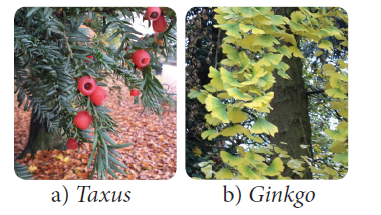Gymnosperms are a group of seed-producing plants that are predominantly known for their cone-bearing nature. Unlike angiosperms (flowering plants), gymnosperms do not produce flowers or fruits. The seeds of gymnosperms are exposed and not enclosed within an ovary, giving them their name, which means “naked seeds.”
In this blog post, we will explore the characteristic features of gymnosperms, the types of gymnosperms, and their economic importance.
Characteristic Features of Gymnosperms
 >
>Gymnosperms possess unique characteristics that distinguish them from other plant groups. Here are the key features:
- Naked Seeds: Gymnosperms produce seeds that are not enclosed in fruits. The seeds develop on the surface of scales or leaves, often in cones.
- Woody Plants: Most gymnosperms are perennial, woody plants, with many species being large trees (like pines and firs). Very few are shrubs.
- Vascular Tissues: Gymnosperms have well-developed vascular tissues (xylem and phloem), allowing efficient transport of water and nutrients.
- Cones or Strobili: The reproductive structures in gymnosperms are typically cones (male cones produce pollen, and female cones bear ovules and seeds).
- Needle-Like or Scale-Like Leaves: Many gymnosperms, such as pines and firs, have needle-shaped leaves adapted to conserve water. Some, like cycads, have large, compound leaves.
- Evergreen Nature: Most gymnosperms are evergreen, retaining their leaves throughout the year. Some exceptions include deciduous gymnosperms like larches.
- Resin Production: Gymnosperms produce resin, a sticky substance that protects them from insect attacks and microbial infections.
- Pollination by Wind: Gymnosperms primarily rely on wind pollination. Pollen grains are carried by the wind to reach the female cones.
- Tough Seed Coats: The seeds of gymnosperms have a tough outer covering that protects them from environmental stress and predators.
- Secondary Growth: Gymnosperms exhibit secondary growth, leading to the thickening of stems and the formation of wood (xylem) over time.
Types of Gymnosperms
Gymnosperms are classified into four major divisions:
1. Cycadophyta (Cycads)
- Characteristics: Cycads are palm-like plants with large, compound leaves and stout trunks. They are dioecious, meaning male and female cones are borne on separate plants.
- Examples: Cycas, Zamia, Dioon.
- Habitat: Mostly found in tropical and subtropical regions.
2. Ginkgophyta (Ginkgo)
- Characteristics: Ginkgo biloba is the only living species in this division. It has fan-shaped leaves and is deciduous, losing its leaves annually. Ginkgo is also dioecious.
- Example: Ginkgo biloba.
- Habitat: Native to China, widely cultivated for ornamental and medicinal purposes.
3. Coniferophyta (Conifers)
- Characteristics: Conifers are the largest group of gymnosperms and include many of the world’s most massive and long-lived trees. They have needle-like or scale-like leaves and are mostly evergreen.
- Examples: Pinus (pine), Cedrus (cedar), Abies (fir), Sequoia (redwood).
- Habitat: Conifers thrive in cold, temperate regions, with some species adapted to warm climates.
4. Gnetophyta (Gnetophytes)
- Characteristics: Gnetophytes are unique gymnosperms with some angiosperm-like features, such as vessels in their xylem. They can be woody vines, shrubs, or trees.
- Examples: Gnetum, Ephedra, Welwitschia.
- Habitat: Found in tropical and arid regions.
Economic Importance of Gymnosperms
Gymnosperms play a significant role in human life, with many species being economically valuable. Here are some of their key contributions:
1. Timber Production
Gymnosperms, especially conifers, provide high-quality timber used in construction, furniture making, and paper production. Wood from species like pine, cedar, and fir is durable, making it suitable for various industrial applications.
2. Resin and Turpentine
Many gymnosperms produce resin, which is used to manufacture products like turpentine, varnishes, adhesives, and pharmaceuticals. Pine resin, for example, is harvested to produce turpentine oil.
3. Medicinal Uses
Several gymnosperms have medicinal properties. For example:
- Ginkgo biloba is widely used in traditional medicine for improving memory and cognitive functions.
- Ephedra species produce alkaloids like ephedrine, used in treating respiratory conditions like asthma and bronchitis.
4. Ornamental Plants
Many gymnosperms, such as cycads, Ginkgo biloba, and certain conifers, are cultivated as ornamental plants in gardens and parks due to their aesthetic appeal.
5. Edible Products
Some gymnosperms produce edible seeds and other plant parts:
- Pine nuts (seeds of Pinus species) are a valuable food source in many cultures.
- Sago, derived from the stems of Cycas, is used as food in parts of Asia.
6. Pulp and Paper Industry
Conifers, such as pines and spruces, are extensively used in the pulp and paper industry. The long fibers in conifer wood make it ideal for producing high-quality paper.
7. Ecological Importance
Gymnosperms play a crucial role in maintaining the stability of ecosystems. They provide habitat and food for various animals and are essential in regulating the carbon cycle by sequestering large amounts of carbon dioxide.
Conclusion
Gymnosperms are an ancient and diverse group of plants that continue to play a vital role in both natural ecosystems and human economies. From providing timber and resin to serving as ornamental plants and medicinal resources, gymnosperms have a wide range of uses. Their evolutionary significance and adaptability have allowed them to thrive in various habitats, contributing immensely to the plant kingdom’s diversity.